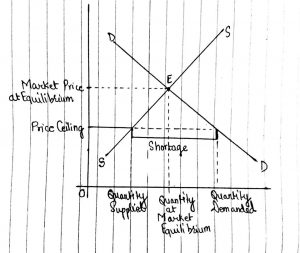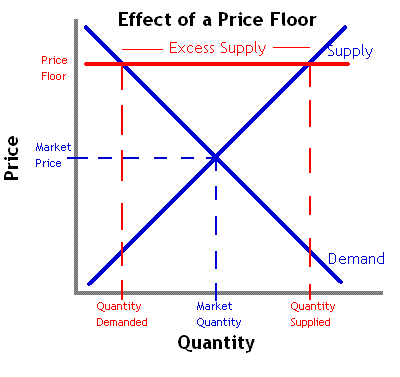What is price ceiling?
Price ceiling is a measure of price control imposed by the government on particular commodities in order to prevent consumers from being charged high prices.
Price ceiling can also be understood as a legal maximum price set by the government on particular goods and services to make those commodities attainable to all consumers.
Effect of price ceiling
Price ceiling is practiced in an attempt to help consumers in purchasing necessary commodities which government believes to have become unattainable for consumers due to high price. However, price ceiling in a long run can cause adverse effect on market and create huge market inefficiencies. Some effects of price ceiling are
Shortage
If price ceiling is set above the existing market price, there is no direct effect. But, if price ceiling is set below the existing market price, the market undergoes problem of shortage.
When price ceiling is set below the market price, producers will begin to slow or stop their production process causing less supply of commodity in the market. On the other hand, demand of the consumers for such commodity increases with the fall in price. And with this imbalance between supply and demand of the commodity, shortage is created in the market.

Government rationing and queuing
When there is extreme shortage in the market, government begins rationing distribution to restrict the demand of the consumers. As a result, consumers won’t be able to utilize as much goods as they need.
Government rationing also results in consumers needing to stay in queue for great deal of times, and this can be troublesome to elderly, disabled and other people who cannot afford to stay in line for a long time.
Black market
Shortage of commodities encourages black market. Sellers begin trading commodities to relatives and friends, and they start charging other people prices multiple times higher than that of price ceiling.
Degradation of quality
Producers won’t be able to generate desirable profit when government set price ceiling. During such condition, many producers may use raw materials of comparatively lesser quality in order to maintain same or almost same revenue as before.
What is price floor?
Like price ceiling, price floor is also a measure of price control imposed by the government. But this is a control or limit on how low a price can be charged for any commodity.
It is legal minimum price set by the government on particular goods and services in order to prevent producers from being paid very less price.
Price ceiling as well as price floor are both intended to protect certain groups, and these protection is only possible at the price of others. Price floor is typically proposed to ensure good income of people involved in farming, agriculture and low-skilled jobs.
Effect of price floor
Government enforce price floor to oblige consumer to pay certain minimum amount to the producers.
Government set price floor when it believes that the producers are receiving unfair amount. Price floor is enforced with an only intention of assisting producers. However, price floor has some adverse effects on the market. These effects are
Supply surplus
If price floor is less than market equilibrium price then it has no impact on the economy. But if price floor is set above market equilibrium price, immediate supply surplus can be observed.
At higher market price, producers increase their supply. In contrast, consumers’ demand for the commodity will decrease, and supply surplus is generated.

Government intervention
When price floor is continued for a long time, supply surplus is generated in a huge amount.
In case of producer surplus, producers would have reduced the price to increase consumers’ demands and clear off the stock. But since it is illegal to do so, producers cannot do anything. So, government has to intervene and buy the surplus inventories. Government may sell these inventories in situation when there is scarcity of those commodities, or it can also distribute to the poor people and public entities.
Minimum wage and unemployment
If minimum wage is set below the market price, no effect is seen. But if minimum wage is set above market price, employers may distribute more work among few workers and terminate rest of the workers in order to not to pay more wage to more workers. Setting price floor will obviously help few workers in getting higher wage. But at the same time, other workers will also have to lose their jobs, creating unemployment.
